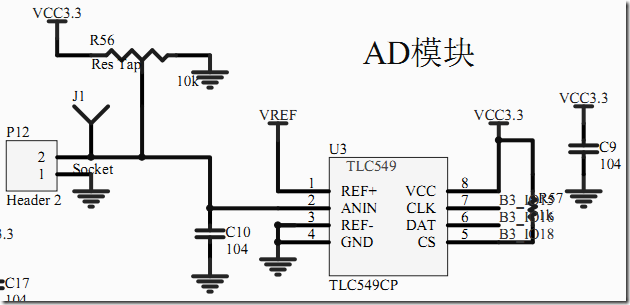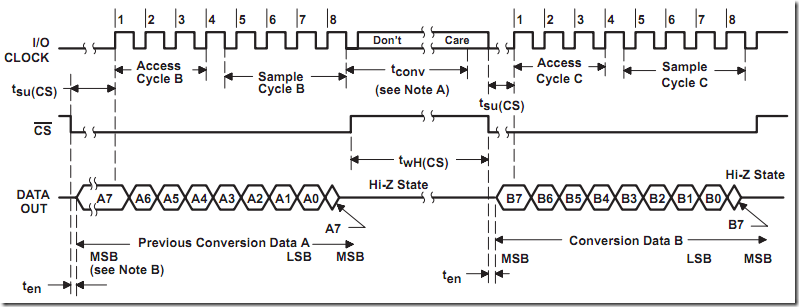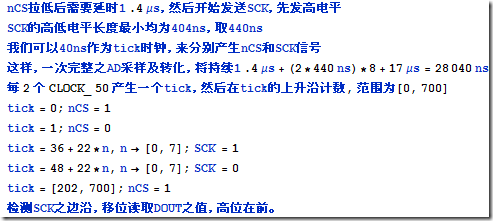[原创].串行ADC TLC549读取实验,Verilog版本
原理图
时序图
笔记
源代码
顶层文件
module tlc_549_test(
input CLOCK_50, // 板载50MHz时钟
input RST_N,
//
output ADC549_CLK,
output ADC549_CS_N,
input ADC549_DATA,
//
output [7:0] SEG7_SEG, // 七段数码管 段脚
output [7:0] SEG7_DIG // 七段数码管 位脚
);
wire [7:0] ad_data;
tlc549_driver tlc549_driver_inst(
.CLOCK_50(CLOCK_50),
.RST_N(RST_N),
//
.ad_enable(1'b1),
.ad_data(ad_data),
//
.nCS(ADC549_CS_N),
.SCK(ADC549_CLK),
.SDO(ADC549_DATA)
);
seg7x8_drive u0(
.i_clk (CLOCK_50),
.i_rst_n (RST_N),
.i_turn_off (8'b1111_1100), // 熄灭位[2进制]
.i_dp (8'b0000_0000), // 小数点位[2进制]
.i_data (ad_data), // 欲显数据[16进制]
.o_seg (SEG7_SEG),
.o_dig (SEG7_DIG)
);
endmodule
数码管驱动http://www.cnblogs.com/yuphone/archive/2011/04/24/2026318.html
TLC549驱动
module tlc549_driver
(
input CLOCK_50,
input RST_N,
//
input ad_enable,
output reg [7:0] ad_data,
//
output reg nCS,
output reg SCK,
input SDO
);
function integer log2(input integer n);
integer i;
for(i=0; 2**i <=n; i=i+1) log2=i+1;
endfunction
/**************************************
* 生成40ns的tick时钟
**************************************/
reg cnt_40ns;
always@(posedge CLOCK_50) cnt_40ns <= cnt_40ns + 1'b1;
wire tick_40ns = (cnt_40ns == 1'b1) ? 1 : 0;
/**************************************
* 根据tick时钟生成ad基准计数器
**************************************/
reg [log2(700):1] ad_ref_cnt; // [0,700]
always@(posedge CLOCK_50, negedge RST_N)
if(!RST_N) ad_ref_cnt <= 0;
else begin
if(!ad_enable) ad_ref_cnt <= 0;
else begin
if(tick_40ns) begin
if(ad_ref_cnt < 700)
ad_ref_cnt <= ad_ref_cnt + 1'b1;
else ad_ref_cnt <= 0;
end
end
end
/**************************************
* 根据基准计数器生成串行信号
**************************************/
reg samping_flag; // 采样标志
always@(posedge CLOCK_50, negedge RST_N)
if(!RST_N) begin
nCS <= 1;
SCK <= 0;
samping_flag <= 0;
end
else begin
if(tick_40ns) begin
case(ad_ref_cnt)
// 采样期
36,58,80,102,124,146,168,190 : SCK <= 1;
48,70,92,114,136,158,180,202 : SCK <= 0;
default : ; // 缺省不操作
endcase
case(ad_ref_cnt)
0 : nCS <= 1;
1 : nCS <= 0;
// 转换期
202: nCS <= 1;
default : ; // 缺省不操作
endcase
case(ad_ref_cnt)
0 : samping_flag <= 0;
// 采样期
36 : samping_flag <= 1;
// 转换期
202: samping_flag <= 0;
default : ; // 缺省不操作
endcase
end
end
wire samping_end = (ad_ref_cnt == 202) ? 1 : 0; // 采样结束标志
/**************************************
* 根据串行信号读取串行样本数据
**************************************/
reg [7:0] sample_data;
always@(posedge SCK, negedge RST_N)
if(!RST_N) sample_data <= {8{1'b0}};
else begin
if(SCK) begin
if (samping_flag != 0) begin
sample_data[7:1] <= sample_data[6:0];
sample_data[0] <= SDO;
end
end
end
always@(posedge CLOCK_50, negedge RST_N)
if(!RST_N) ad_data <= {8{1'b0}};
else begin
if (samping_end)
ad_data <= sample_data;
else ad_data <= ad_data;
end
endmodule
Signaltap硬件仿真











 浙公网安备 33010602011771号
浙公网安备 33010602011771号